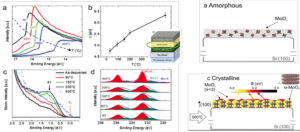Members: Nadine Witkowski, Hervé Cruguel
Collaborations: Morten Madsen, University of Southern Denmark, Synchrotrons (Soleil, BESSY, Elettra, MAXIV)
The goal of this research activity is to study the electronic structure of interfaces in organic-based solar cells to understand the mechanisms that promote or limit charge transfer within the device. The interfaces are prepared in-situ under vacuum by thermal evaporation or electrospray deposition of sensitive organic molecules. We are particularly interested in oxide layers carrying positive and negative charges and their interfaces with active organic semiconductor molecules. The oxide layers are prepared at low temperature in Prof. Morten Madsen’s group and sent to INSP for electronic structure studies.

Caption: Left: Exit work (a,b), valence band (c), 3d core level of Mo as a function of annealing temperature of molybdenum oxide; right: structural model of the oxide layer [3]
An important part of our activity at INSP is to study the electronic structure of these materials by combining optical and in situ electronic spectroscopy techniques. In particular, we perform photoemission measurements in the laboratory or on synchrotron to understand the band alignment at the interfaces and the electronic coupling between layers. These spectroscopic studies are linked to structural studies by X-ray diffraction and near-field microscopy to understand how the structure and nature of the interfaces can influence the performance of the devices.
Thesis
- Dylan Amelot, 2018-2021
- Mariam Ahmad, 2020-2023 co-direction avec Southern Denmark University (SMART – Structures of Materials in Real Time, Ministry of Higher Education and Science (UFM))
Publications
Dylan Amelot, Mehrad Ahmadpour, Quim Ros, Hervé Cruguel, Nicolas Casaretto, Albano Cossaro, Luca Floreano, Morten Madsen, Nadine Witkowski. Deciphering Electron Interplay at the Fullerene/Sputtered TiOx Interface: A Barrier-Free Electron Extraction for Organic Solar Cells. ACS Applied Materials & Interfaces 2021, 13 (16) , 19460-19466. https://doi.org/10.1021/acsami.1c01966
[1] Mina Mirsafaei, Pia Bomholt Jensen, Mehrad Ahmadpour, Harish Lakhotiya, John Lundsgaard Hansen, et al.. Sputter-Deposited Titanium Oxide Layers as Efficient Electron Selective Contacts in Organic Photovoltaic Devices. ACS Applied Energy Materials, ACS, 2019, 3 (1), pp.253-259. ⟨10.1021/acsaem.9b01454⟩. ⟨hal-02995171⟩
[2] Mehrad Ahmadpour, André Fernandes Cauduro, Christophe Méthivier, Birgit Kunert, Chiara Labanti, et al.. Crystalline Molybdenum Oxide Layers as Efficient and Stable Hole Contacts in Organic Photovoltaic Devices. ACS Applied Energy Materials, ACS, 2018, 2 (1), pp.420-427. ⟨10.1021/acsaem.8b01452⟩. ⟨hal-02097260⟩
[3] André Luis Fernandes Cauduro, Roberto dos Reis, Gong Chen, Andreas K. Schmid, Christophe Méthivier, et al.. Crystalline Molybdenum Oxide Thin-Films for Application as Interfacial Layers in Optoelectronic Devices. ACS Applied Materials & Interfaces, Washington, D.C. : American Chemical Society, 2017, 9 (8), pp.7717-7724. ⟨10.1021/acsami.6b14228⟩. ⟨hal-01464322⟩

